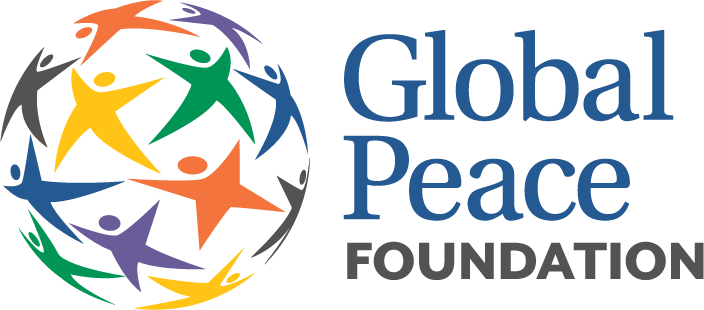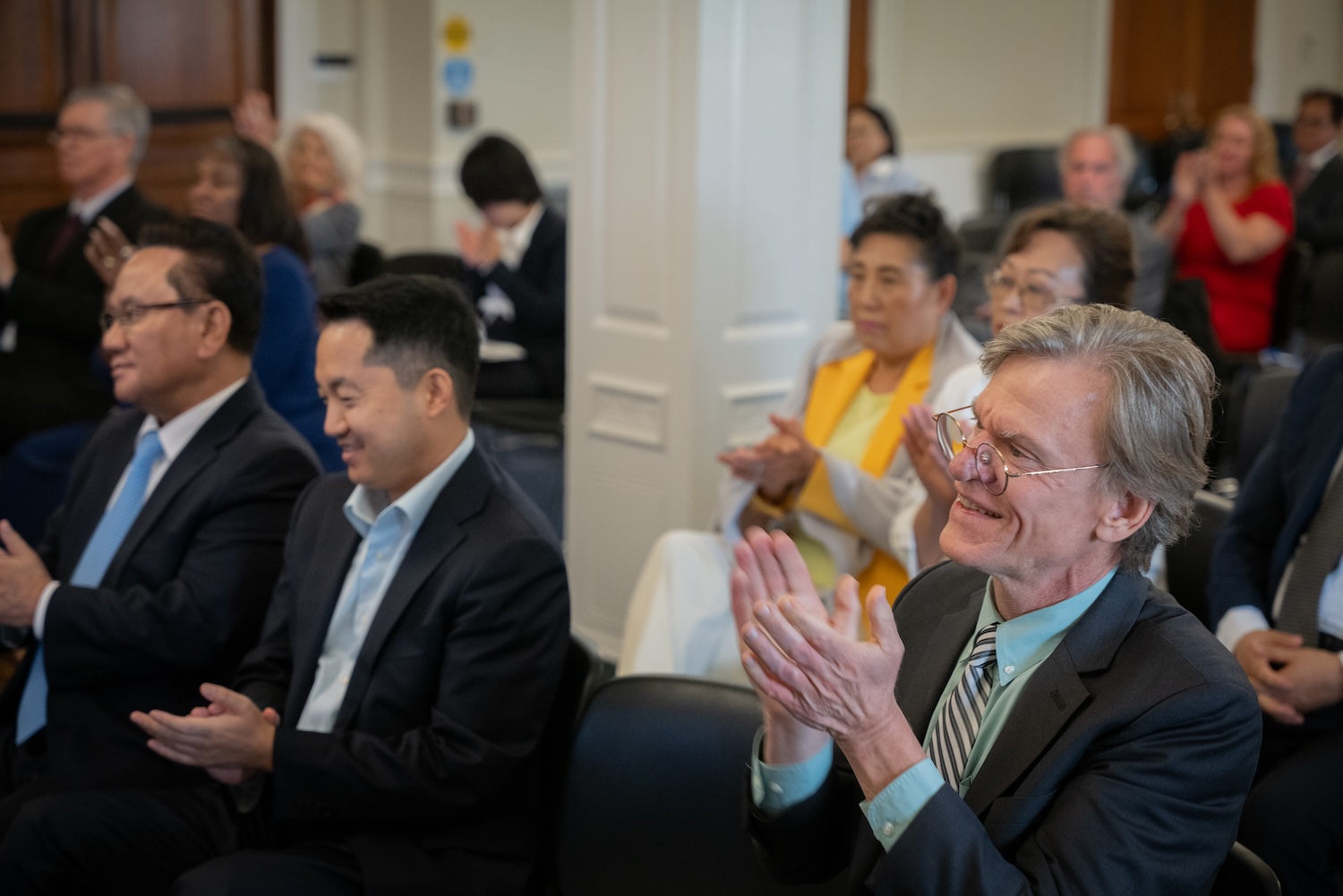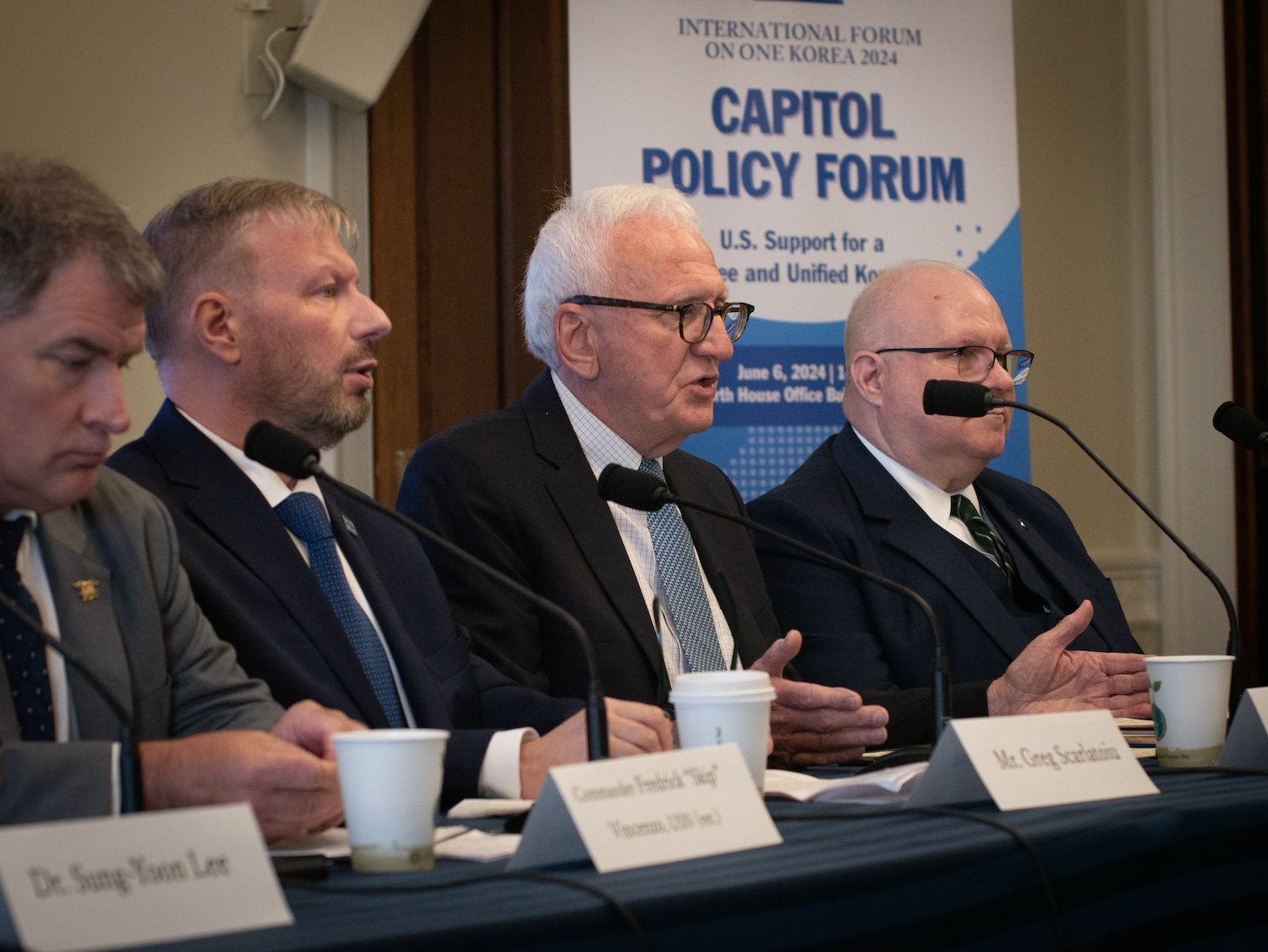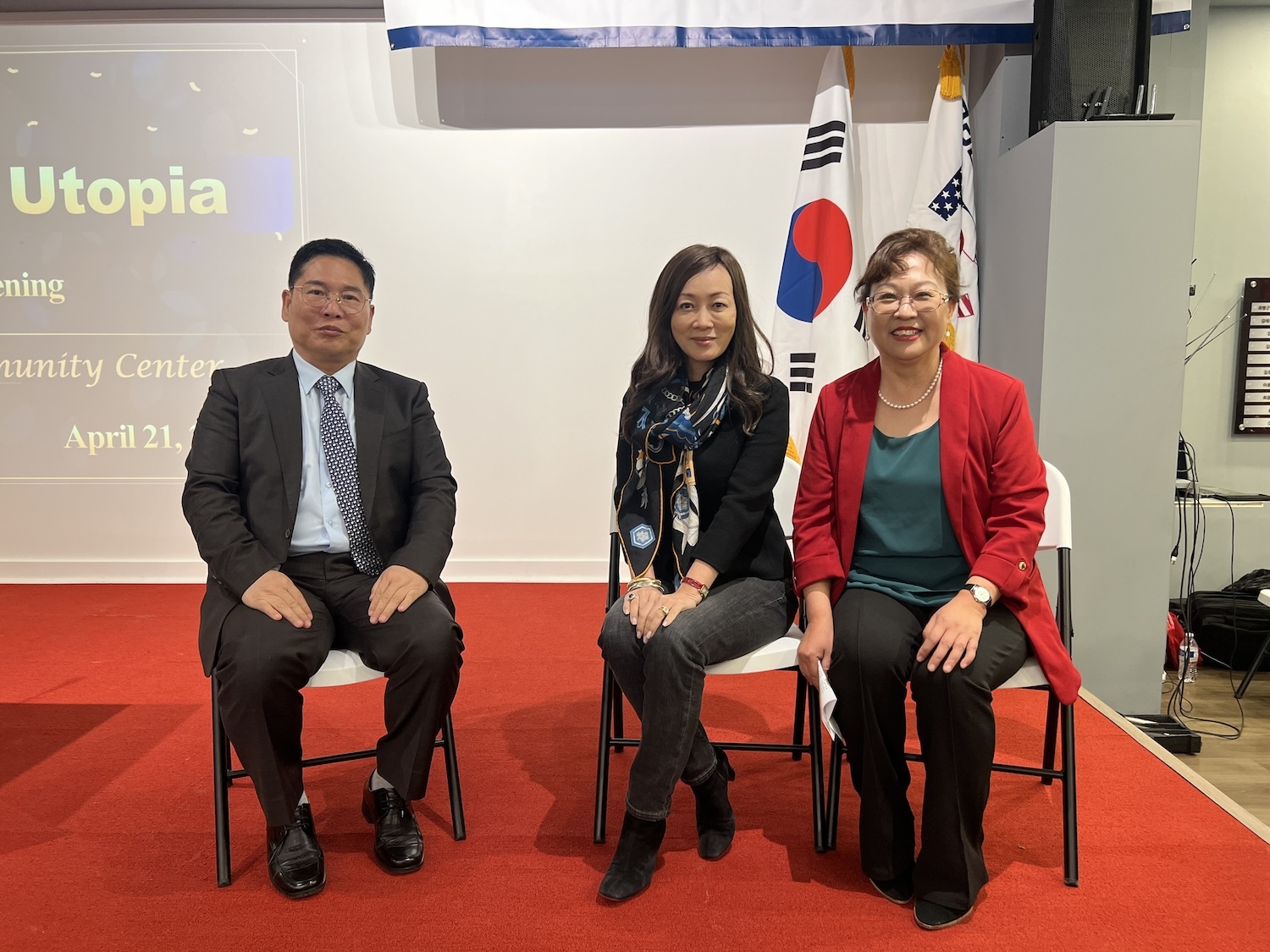International Forum on One Korea
Free and Unified Korea: A Catalyst for Regional and Global Peace and Development
Dr. Hyun Jin Preston Moon
Global Peace Foundation Founder & Chairman
Opening Plenary Keynote Address
Fairmont Ambassador Hotel ♦ Seoul, South Korea August 13, 2022
Distinguished guests, ladies and gentlemen:
It is my distinct pleasure and honor to welcome all of you to the newly built Parc 1 facility located here in Yeouido, the political and financial center of Seoul, for this very significant forum examining the vision for a free and unified Korea. Special thanks to the distinguished leaders and policy experts who are contributing to these important deliberations, in person and through the virtual forum.
In a few days, we will commemorate once more the end of World War II in the Pacific and, with it, Korea’s liberation from Japanese colonial rule. It was a moment of great hope for the Korean people, who believed they would finally be able to realize their historic aspiration of creating a model nation rooted in the founding providential mandate of hongik ingan – to “live for the greater benefit of all mankind.” Tragically, however, that did not happen. Instead, Korea became artificially divided along the ideological lines of the Cold War and has remained in that unnatural state for more than 77 years.
As a result, that unfulfilled dream of our ancestors to create a new, western-style model nation that was independent and free, casts a shadow over our celebrations. Our collective destiny as Koreans, still remains to be achieved. It is even more urgent today, given the current volatile and threatening geopolitical circumstances in Europe and, especially, in this region. Russia’s brutal war of aggression against Ukraine, and China’s assertion of its right to take control of Taiwan, by force, if necessary, remind us that the Cold War is not completely behind us.
Democracy and the Sovereignty of God
These confrontations stem, at root, from conflicting worldviews. It is important to note that, although Russia and China have adopted elements of the free market economy, both nations uplift the power of the state above all else with little regard for the rights of their own citizens or even of their neighbors. The western democracies were shaped by, or had adopted, the Judeo-Christian ethos that emphasized the sanctity of human life, “created in the image of God.” Unlike them, however, Russia still maintains the political philosophy and aspirations of the Soviet past, couched in a new Russian nationalism, while China has never abandoned the Maoist revolution or changed its one-party Communist rule.
They disregard the universally accepted truth of all western democracies, immortalized in the United States Declaration of Independence, that all human beings are “endowed by the Creator with certain unalienable rights” among which are “life, liberty, and the pursuit of happiness.” Most importantly, they fail to recognize that the main purpose of government or the state is to ensure that those rights and freedoms are protected and maintained for their citizens. In doing so, they reject a core principle expressed in the Declaration that our essential rights and freedoms come from a transcendent Creator or God, and that no human institution or government can deny or abrogate them.
With the current geopolitical threat of statist regimes, as well as the rise of secular Marxist ideals in “woke” popular culture, democratic nations are struggling to secure the fundamental rights and freedoms of their citizens in addition to maintaining their fragile institutions. The sanctity of human life that comes from the Creator, which had once been the bedrock of most western democracies, is now being challenged at home and abroad. These disturbing trends make it even more important than ever for democracies to identify and acknowledge where true freedoms and rights arise from.
It should be self-evident that without recognizing a transcendent source for these ideals, imperfect human beings and the institutions they create would inevitably abridge them for the sake of a greater collective purpose rooted in the almighty state. The founders of the United States and the authors of the Declaration clearly understood human limitations; they made it a point to counter the prevalent belief during the 18th century in the “divine right of kings” with the principle that “unalienable rights” and freedoms of all people come from the Creator. In essence, the founders countered human claims to ultimate authority with that of God. This truth that fundamental freedoms and rights come from “the sovereignty of God” has endured the tests of time and has allowed western democracies to thrive.
Confrontation of worldviews and the current reality of the North
Without the acknowledgment of God’s sovereignty as the source of fundamental rights and freedoms, serious problems arise. A good example is the UN’s Universal Declaration of Human Rights that does not recognize the Creator as the source of those rights, due to its creation during the height of the Cold War. Consequently, the UN cannot deal effectively with authoritarian and statist regimes that decide for themselves what rights and freedoms their subjects are allowed and what they are denied.
The two Koreas represent the most extreme example of this confrontation in worldviews – between a democratic South and a statist dictatorship in the North. The DPRK is a nuclear-armed state whose leadership has sacrificed the well-being of its people to achieve that status. There is no doubt that they would use force to unite the peninsula, for they were the instigators of the Korean War in 1950 that, technically, still has not ended. Here, as well as on other fronts, geopolitical uncertainty has intensified, increasing the danger that a false step or miscalculation could lead to a major escalation and catastrophe.
This is certainly true for North Korea, where the geopolitical situation is exacerbated by internal tensions. The regime has long sacrificed development for its idea of security, foisting extreme hardship and deprivation upon its people. As a result, there is a real danger of food shortages producing famine on a scale to rival the disaster of the mid- 1990s.
People in the DPRK, today, no longer live in a cocoon, however, with no information from the world outside. The current generation of North Koreans has experienced the freedom of enterprise and choice, however restricted, offered by the jangmadang informal markets. They watch TV dramas from China and South Korea and do not accept the propaganda that, however harsh their own lives might be, those of their Southern brethren are even worse.
The regime fears the confluence of a more informed, less unconditionally loyal population, with the greater hardships they are forced to endure. The situation today is very different from the past. When there was the potential of conflict between the DPRK and the United States, the North Korean regime was clearly more concerned about the threat of an uprising of the Korean people than it was about the US. The current reaction of the DPRK is typical of authoritarian regimes under pressure – enforcing tighter security at the border with China and cracking down on those accessing foreign media. When loyalty is replaced by fear and the general population suffers increasing hardship, the situation becomes unsustainable. Change is bound to come. We just don’t know when, or in what form, it will happen.
The Korean Dream
The Korean people today face two major challenges: unifying their divided homeland and rediscovering their Korean identity. The two are intertwined. Once we understand that unification is not just about the dealings of governments but is the coming together of a separated people, then it becomes clear that a strong sense of Korean identity is essential for the Korean people in the South and in the North to be able to reunite.
That identity has been eroded in the North through 77 years of oppression and suffering. But it is also disappearing here in the South. After the devastation of the Korean War, a total national effort was invested into developing the economy and securing the country against another invasion.
That produced remarkable prosperity but we now see that it came at a significant cost. The chaebol system that originally drove growth has become a drag upon entrepreneurial enterprise. Highly educated young people suffer debilitating unemployment and many can even no longer afford to get married.
To navigate this uncertain future, a clear national purpose is essential, but has been seriously lacking. To move beyond the stagnant status quo, a new approach is needed, with a broad vision and a movement to advance it. That vision, I believe, is the Korean Dream. As I explain in my book of that title, to build our future we need to learn from our past.
Before the tragic 20th century, before the ideological conflict between communism and democracy and the bloody division it produced, Koreans shared a 5,000-year history as one, homogeneous people with a common culture. That culture was rooted in ideals and principles that arose from the founding spirit of Dangun. Foremost among these was the ideal of hongik ingan, “living for the greater benefit of all mankind.”
From that very beginning of our history, the Korean people held to a moral vision that embraced all people. This was their providential mandate, and to fulfil it was their destiny. Koreans have always embraced different faith traditions that have come to this land. But our ancestors digested those traditions and gave them a unique Korean character, rooted in the hongik ingan tradition.
They recognized Hananim, one Lord or God above all, whatever the variety of their religious expression. The Korean flag itself, the taegeukgi, is a lesson in the principles that sustain the harmony of the universe. It is an example of the spiritual character inherent in the Korean people across their history.
This is the shared heritage of all Koreans that transcends the current ideological, political and national divisions. It is the root to which Koreans in both North and South must be re-connected to provide the vision and energy that can reunify a separated people. Arising from this history, the Korean Dream promise is for a free and unified Korea, a new nation, in which the fundamental, God-given rights of all people will be secured, under the sovereignty of God.
Need for unification centered on Korean Dream
This resonates with the ideals of the 1919 Sam Il Independence Movement. Certainly, they wanted to end Japanese colonial rule. But, more than that, they sought to create a nation that lived up to the highest ideals. They even envisioned a free Korea working together with Japan for the benefit of the region and the world. Here was the spirit of hongik ingan in action, and the aspirations of the nation united around it.
The end of World War II brought an end to Japanese colonial rule that we celebrate every August 15. It also brought the opportunity to create a free and unified Korea that the Sam Il Independence Movement had longed for. UN mandated elections were to be held in 1948 across the whole country, but they never happened.
Despite visits by Korean leaders from the South to persuade Kim Il Sung to work with them for a united Korea, he and his Soviet sponsors at that time, declined to hold elections in the North. They were held only in the South and, shortly after, two separate states were founded, a division that lasts until this day. The aspirations of the Sam Il Movement remain unfulfilled.
The separation of the Korean people has persisted far too long. The current status quo cannot endure. The situation on the peninsula is the final remnant of the Cold War, and a dark legacy of former colonialism. It is long past time to unify the peninsula, and the Korean Dream is the way forward to forge a new and better future.
The Korean Dream can inspire and motivate Koreans in both the South and the North to reconnect with their unique identity and heritage in order to take ownership over our common future. At the same time, it offers North Korea the prospect of becoming part of a united and independent nation that enjoys great prosperity as well as fundamental freedoms and rights. Most importantly, it will safeguard the Korean homeland from an increasingly aggressive and powerful China and Russia.
Over the next three years, we will work to greatly expand the understanding of and support for the Korean Dream approach, both within Korea and internationally. This initiative already has significant momentum through Action for Korea United, an unprecedented coalition of nearly one thousand civil society organizations working collaboratively to promote a free and unified Korea. Its education programs have been informing Korean professionals, organizations, opinion leaders, and civil society stakeholders across the social spectrum. The progress of its work will continue to accelerate in the coming years as it builds consensus around unification and the character of the new Korea that will emerge from it.
Conclusion: Call to Action
We will build broad support in South Korea and the diaspora around a national vision for peaceful unification based upon the Korean Dream. By 2025, the 80th anniversary of liberation, we will hold public rallies in towns and cities all over the South in support of a free and unified Korea, reminiscent of the Sam Il Movement for independence more than a hundred years ago. The Korean Dream will galvanize the hearts of every Korean to realize our collective destiny and, thus, honor the legacy of our ancestors through fulfilling the hopes of our forefathers.
Such a powerful expression of solidarity behind a common vision, led by the Korean people themselves, instead of any government or political party, will enable the South to bypass its hyper-partisan divide and will let their brethren in the North know that they are not alone. This will be an expression of a truly “bottom-up” movement of the people beyond national and ideological divisions and, as a consequence, would also be a catalyst for greater international recognition and support. Through it, we the Korean people, will achieve what the world deems impossible.
I call upon Koreans everywhere, young and old, at home and abroad, to take ownership over the Korean Dream, creating a new, model nation from the ashes of a divided peninsula, one that guarantees freedom and human rights for all.
This is not just a call for Koreans, but for all who believe in freedom and fundamental human rights and that nations must protect those rights and recognize their source. That is the Korean Dream. It is your dream and your cause too.
If we succeed then, without a doubt, Korean unification will be recognized as the most monumental achievement for world peace and will spark the light of hope and possibility for the 21st century.
In closing, let me remind you of the prophetic words of Genghis Khan. He said, “If one person has a dream it is but a dream, but if everyone shares that dream, it will become reality.”
By each and every one of us owning the Korean Dream as our own personal dream, let us realize the providential destiny of creating a unified new nation together as one Korean people. Then, let us offer this new nation, centered upon the sovereignty of God, to the world and fulfill our providential mandate of “living for the greater benefit of all mankind.”
Thank you very much and may God bless you and your families.



